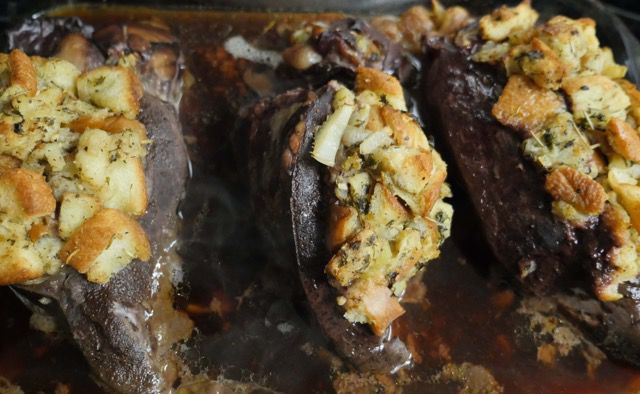Some like it grilled like a steak or simmered into a comforting stew. Others say it tastes delicious when roasted and stuffed like a Thanksgiving turkey. No matter how it’s prepared, most agree that as a distinctive Alaska delicacy, moose heart is hard to beat.
The star dish of the Positive Connection Night potluck — hosted by the University of Alaska Fairbanks’ Rural Student Services, a home away from home for rural and Alaska Native students — was stuffed moose heart. The heart had been donated by a subsistence hunter who wanted to share a taste of subsistence home cooking with UAF students.
A moose heart is about the size of a football. It’s a dark meat that feels rough on the outside but is silky smooth on the inside. The moose heart prepared for the potluck was already in three separate pieces rather than a whole heart. Epicureans prefer to stuff the whole heart, for a dramatic effect when the heart is sliced.
Some of the Alaskan students at the potluck said that the best parts of the moose, like the heart and other vital organs, are given to elders as a way to show respect. It’s also a prized gift for potlatches and other celebrations. Others talked about how moose heart and liver are the parts of the animal that are eaten first and prized for their delicate taste and nutritional value.
Brianna Pauling, an RSS advisor and office manager, prepared the stuffed moose heart using a recipe that Keri Edwards shared with Alaska Fish & Wildlife News. The earthy flavor of moose heart is reminiscent of liver but nowhere as intense and with a meatier texture.
Although UAF student Shania Perkins grew up eating moose meat, she tried moose heart for the first time at the potluck.
“The stuffed moose heart tasted like moose meat, but it was denser and chewier than I thought it would be,” said Perkins, who grew up in Gold King Creek. “I liked it, even though I didn’t think I would.”
If you don’t have a moose heart, the recipe can be prepared using caribou or deer heart.
If you are not a hunter, you can use a beef heart purchased from the butcher. The stuffing recipe can be modified, as well. Some people like to use cornbread or wild rice instead of a traditional bread stuffing. Other chefs add dried cranberries and pecans to their stuffing.
The Alaska Department of Fish and Game gave me permission to share Edwards’ family recipe with Fairbanks Daily News-Miner readers. The recipe is credited to Diana Edwards. According to tradition, you thank the moose for giving its life for you before digging in.
Stuffed Moose Heart
Preparing the heart: When the heart is still fresh, soak it in a bucket of cold sea water or fresh water to flush out the blood. Rinse well. Trim the fat and the tops of the valves off so that the final product is mostly red and the top is relatively level, with clear access to the chambers of the heart.
At this point, the heart can be kept in a freezer if wrapped well in plastic wrap and butcher paper. However, it is best when eaten fresh.
Ingredients
1 moose heart
½ loaf of your favorite white bread
about 4 stalks of celery, chopped into small pieces
1 onion, chopped
2 cloves garlic, minced
2 tablespoons parsley leaves
2 teaspoons rosemary
2 teaspoons oregano
1 teaspoon sage
salt to taste
pepper to taste
olive oil
3 tablespoons butter
water
red wine
soy sauce
Preheat the oven to 350.
In a hot skillet, brown the heart on all sides and set aside to cool.
Put the celery, onion, garlic, parsley, rosemary, oregano and sage in a hot skillet covered with a generous amount of olive oil. Add the butter and sauté until tender, about 10 minutes. Add salt and pepper.
Cube the bread into small bite-size pieces. In a large bowl, combine the cubed bread and everything from the skillet. Make sure that the mixture is somewhat moist. If more moisture is needed, sprinkle a little water or melted butter throughout the dressing. Taste and add salt and pepper as necessary.
Sprinkle salt and pepper into the cavities of the heart. Stuff the dressing into all of its chambers. Put any extra dressing in a small casserole dish with a cover and set aside.
Place the heart in a roasting pan. Mix three parts water, one part red wine and one part soy sauce and pour enough into the bottom of the roasting pan so that it’s about 1 inch deep. Cover the roasting pan and put into the oven.
After about an hour, take some of the liquid out of the roasting pan and drizzle onto the extra dressing in the casserole dish. Cover the dressing and put it in the oven.
Bake the heart until a knife inserted produces clear liquid — expect it to take a couple of hours at least, depending on the size of the moose heart. Try not to puncture the heart more than necessary when testing for doneness, as this will dry it out. When finished cooking, slice the heart diagonally so that most of the slices contain dressing.
